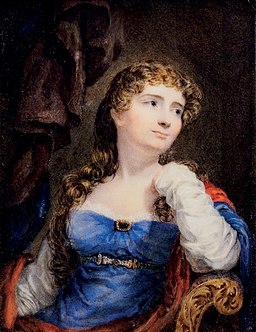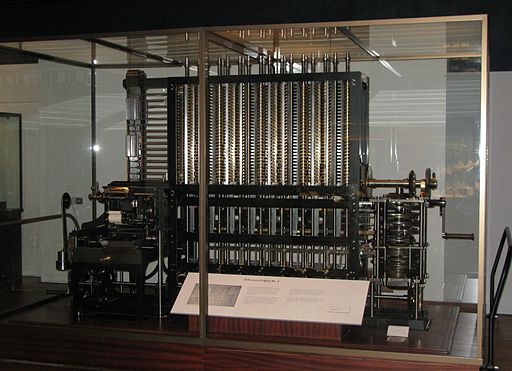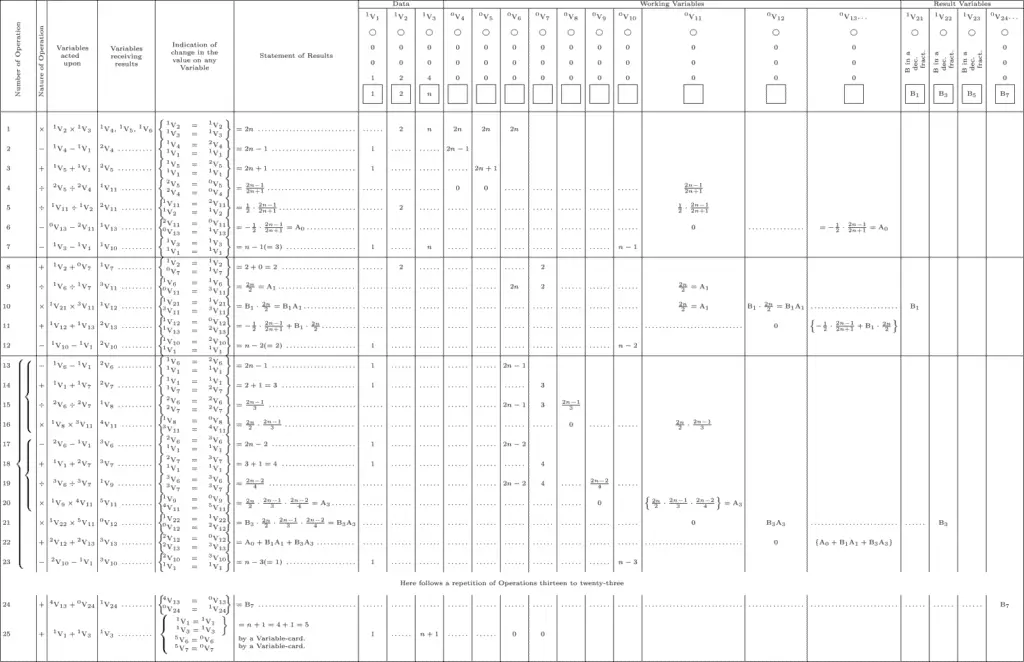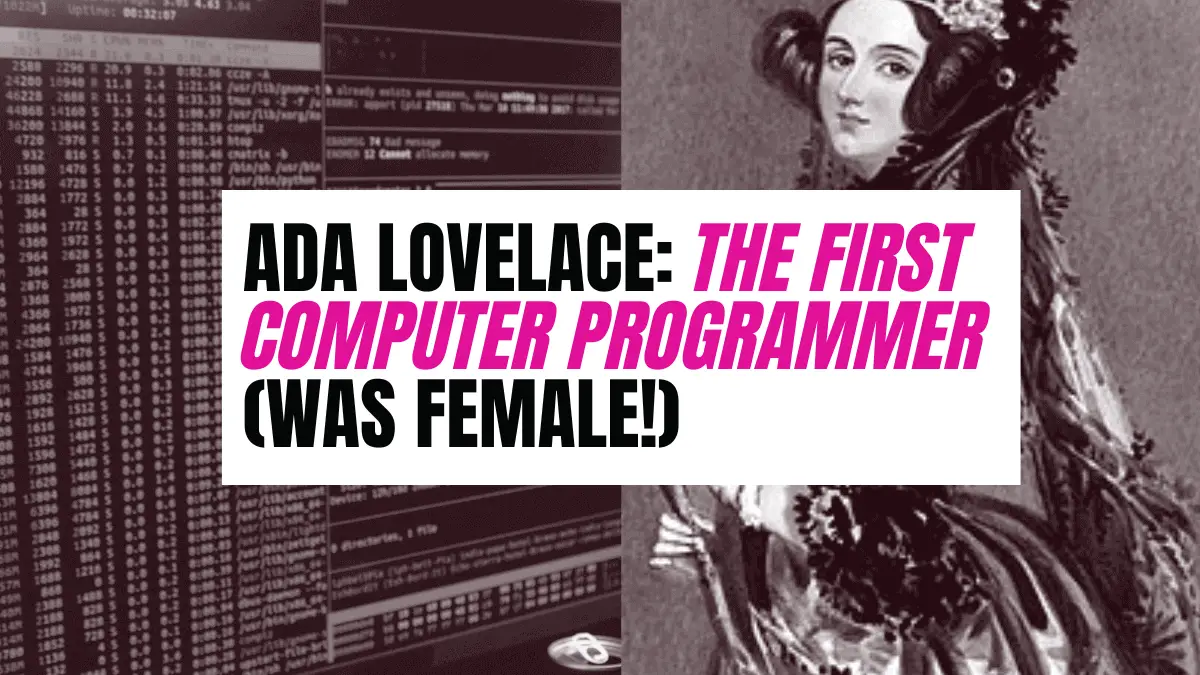Did you know who the first ever computer programmer was? What if I told this programmer lived over 200 years ago and was a lady?
Ada Lovelace was the daughter of the famous poet Lord Byron and a mathematician, Annabella Milbanke. She was highly talented in Mathematics, which led to a long partnership with a famous mathematician, Charles Babbage. She is regarded as the “first computer programmer” for writing the code for calculating Bernoulli numbers on the Analytical Engine in the mid-1800s.
Despite her achievements and working closely with some famous people like Charles Babbage, who are well known in digital technology, her genius work was nearly lost to history. This post will give you a full story on the first ever computer programmer, her early life, achievements, and even last wishes on her deathbed, which most people considered “quite absurd.”
Table of Contents
Early Life
Ada Lovelace was born on December 10th, 1815, to the famous poet Lord Byron and strictly religious Annabella Milbanke. By then, the father-mother relationship was not that “solid” since the two seemed to have divergent views on life and personal goals. They shared virtually nothing in common.

Although Lord Byron was a commendable and loved poet, his conduct raised a couple of eyebrows. He loved drinking his wine from a human skull; he kept a bear for a pet, and most considered him a philander in terms of his sexual relationship. He was open to having relations with both men and women.
The most infamous embarrassment was having relations with his step-sister, Augusta Leigh, which slightly impacted Ada’s relationship with her mother, as you will learn below.

One of his despised lovers, Lady Caroline, once described Lord Byron as “mad, bad, and dangerous to know.” (New York Times)
Mother-Father Separation
As you might expect, the marriage between Lord Byron and Anabella didn’t last long, not even a year. Lord Byron seemed more obsessed with Augusta (his step-sister), and his wife could not keep up with his sexual escapades with actresses. The two separated when Ada was only five weeks old in January 1816.
Lord Byron wrote the following about his daughter Ada during this parting as a poet.
“IS thy face like thy mother’s, my fair child! ADA! sole daughter of my house and heart?” (BartleBy)
Four months after Anabella had left Lord Byron and began proceedings for a legal separation, Lord Byron left England. Ada never met him again in her whole life. Despite that, as Ada grew, she was always fascinated by his father’s works of poetry. Lord Byron died of an illness at the age of 36 in Greece. Ada was only eight years old by then.
Upbringing
Anabella Milbanke (Ada’s mother) was one of the wealthiest women in Britain. She controlled many coal mines in the north of England, among other things. That significantly impacted Ada’s life as Anabella now had the resources to get the best education for he daughter.

One of her main goals was to ensure her daughter never followed her father’s path of “volatile poetic insanity,” as she always referred. According to Anabella, Lord Byron was mentally ill and was only obsessed with writing poems.
To tame Ada’s imagination and ensure she had a proper steer of her life, Anabella introduced Ada to the world of Mathematics and Science. That was not a popular course for women in British Victorian society. Even though her mother aimed to ensure Ada never thought of poetry, Ada surprisingly became obsessed with Mathematics.
To many, this was not unusual as her mother, Anabella, was also a renowned mathematician. Lord Byron used to refer to her as the “Princess of Parallelograms.”
Education
With her resources, Anabella could take care of Ada’s well-being and employ the best tutors for her. Some of these tutors include A British physician and philanthropist, William King, an English social reformer and writer, William Frend, and Scottish polymath, scientist, and writer, Mary Somerville. The latter significantly impacted Ada’s life, as you will read below.
Ada continued to amaze many as she continuously made milestones in her field of Mathematics and Science. One of her tutors, a British mathematician, and logician, Augustus De Morgan, believed that women were incapable of excelling in Science and Mathematics and always said:
“The very great tension of mind which they require is beyond the strength of a woman’s physical power of application.” (Bio Graphics). However, Ada’s success in the field proved this theory wrong.
Apart from Mathematics and Science, Anabella ensured Ada was well educated in other fields of art like sewing, music, literature, history, and geography. Even though non of Ada’s biographies reveal how many languages she knew, the research done by this post shows Ada was well versed in English and French.

Ada’s mathematics and science prowess began to show early when she was 12. After touring Europe for nearly a year, Ada wrote to her mother about a project she had in mind concerning birds and flight, which she called “flyology.” She believed she could develop a machine flying like a bird by flapping its wings.
In her letter, she stated:
“I have got a scheme to make a thing in the form of a horse with a steam engine in the inside so contrived as to move an immense pair of wings, fixed on the outside of the horse, in such a manner as to carry it up into the air while a person sits on its back.” (Digit News)
For this project, she intended to use paper/feathers or silk for the wings, a compass for navigation, and steam to power the machine.
Ada Lovelace, Charles Babbage, and the Difference Engine
At the age of 17, while at a dinner party at her tutor’s place, Mary Somerville, Ada heard about Babbage’s idea of developing a calculating machine. Ada became intrigued by attending a coveted party hosted by Charles Babbage himself, who is today regarded as the “father of computers.”

One of the guests at the party had this to write about the people who were allowed to attend.
“One of the three qualifications for those who sought to be invited were intellect, beauty, or rank.” (Bio Graphics)
Ada fitted in this category due to her talent in Mathematics and Science and also brushing shoulders with renowned tutors from various fields.
Charles Babbage revealed to his guests a project he had been working on at this party. It was a massive calculator machine that could perform mathematical calculations. He called it the Difference Engine.

When built, Babbage’s engine’s ground-breaking design would execute the calculations of an entire army of men. The steam-powered machine would methodically execute complex computations using only addition by partitioning the problem into smaller and smaller bits (principle of finite differences). The device would then print out the values into a table.
Of course, this machine was no match compared to today’s calculators. However, considering the level of technology at the time, the Difference Engine was a massive milestone in Physics and Mathematics in the nineteenth century when the industrial revolution was at its peak.
Tables were used in most calculations, especially in engineering, astronomy, and navigation. Therefore, Babbage’s Difference Engine came at the right moment. It would significantly reduce human error calculations as it had an accuracy of thirty-one decimal places.
To most people at the party, the Difference Engine looked like any other piece of metal used to seeing in Cotton processing plants. However, Ada saw something different. Augustus De Morgan’s wife was also present at this party. Later in her life, when writing about that night, she stated:
“When most of the guests looked on with the expression that savages show on seeing a looking glass, Miss Byron, young as she was, understood its working and saw the great beauty of the invention.” (O’Reilly)
Babbage seemed to have also spotted Ada’s interest in his work, and that night marked the beginning of a friendship and long-life cooperation between the two.
The Analytical Engine
If you are a person interested in history, you might already have noticed that less is said about Babbage’s Difference Engine today. That’s because it never came to be. A disagreement between Babbage’s engineer, Joseph Clement, and lack of funds, led to the stall of development and progress of the Difference Engine.
According to the law in the 19th century, the engineer was the sole owner of the drawings. After the disagreement, Babbage could not access these designs that guided the development of the Difference Engine. With the desire and eagerness to fulfill his dreams, Babbage backtracked to his original concept to develop new plans. In 1834 he came up with an even better one – the Analytical Engine.

It was a ground-breaking invention and regarded as the world’s first programmable computer, which would, in turn, become Ada’s legacy. The engine’s working is similar to today’s computers, the only difference being the power source and the physical size. Babbage’s Analytical Engine was powered by steam and measured at least 45 feet long by 15 feet high.
This engine was made up of four main parts:
- Mill: It was the component where the engine performed mathematical calculations.
- Store: It was a storage that held the data for processing.
- Reader: This component read the input.
- Printer: This component stored the results/ output.
During this era, there had never been such an advanced machine ever built.
After Ada saw the plans and designs for the Analytical Engine that Babbage was working on, she was fascinated. She decided to go and check out one of the most advanced machines of the time to see how it worked – the Jacquard Loom. It was a technology invented in 1803 by a weaver known as Joseph Marie Jacquard.
The exciting thing about the loom was that it could control every warp thread individually, thus creating complex and fancy patterns on the cloth much more quickly and accurately than other technologies of the time. The design patterns were passed to the loom as instruction using punch cards.
The video below shows you a clear illustration of the working of the Jacquard Loom. Quite fascinating.
When Ada returned to Babbage and looked deeper at the Analytical Engine designs, she saw some similarities with the Jacquard Loom. Later in her journals, she wrote:
“The Analytical Engine weaves algebraic patterns just as the Jacquard loom weaves flowers and leaves.” (MIT Press)
During this period of about 10 years, Ada’s personal life also had some impact. She had gotten married and had three kids. However, that did not halt her desire to learn and research more on the analytical engine. Later in her life, she wrote:
“I think I am more determined than ever in my future plans, and I have quite made up my mind that nothing must be suffered to interfere with them. I intend to make such arrangements in town as will secure me a couple of hours daily (with very few exceptions) for my studies.” (Brainy Quote)
Legacy in the Making
Whenever Babbage was giving any lecture, the hall was always full to the brim with intellects and leaders from various parts of the world. One such event was attended by an Italian military engineer, Luigi Federico Menabrea, who later became a prime minister from 1867 to 1869.
After the event, Luigi wrote an impressive article about Babbage’s invention, “Sketch of the analytical engine invented by Charles Babbage Esquir.”
This publication, however, was written in French. It was also detailed, and most of the explanations were mathematical. Since Ada had an in-depth understanding of the machine and its working, she decided to translate the paper and add her own thoughts. When she was done, her notes were three times longer. That was between 1842 and 1843.
The most significant section that gives Ada the credit of “first computer programmer” comes under “Notes by Translator” in “Note G.” There, Ada wrote an algorithm for calculating Bernoulli numbers using the Analytical Engine. That piece of code is termed the “first ever computer program.”

Ada’s contribution would have been lost to history were it not for Alan Turing, who discovered her notes 100 years later in 1940 during the second world war. Using her notes, Turing developed an electro-mechanical device known as “the Bombe” that could decipher German Enigma-machine-encrypted secret messages for the British army.
These notes also surfaced in B.V. Bowden’s book “Faster Than Thought: A Symposium on Digital Computing Machines,” written in 1953. In recognition of Ada’s contribution to Science and Technology, the U.S. Department of Defense developed a high-order computer programming language called Ada programming language.
The Fate of the Analytical Engine
Despite being good at calculations, Babbage was not very good at marketing his inventions. He always had heated arguments with politicians, and his relationship with the parliament grew even sour when he failed to deliver the Difference Engine. These and many more issues led to a lack of funding for his Analytical Engine project.
By this time, Ada was obsessed with the project and did not imagine their research and hard work going in vain. She decided to come up with a plan to save the project and source funds. On August 14th, 1843, she wrote a letter to Babbage requesting him to allow her to take over promoting the project while he worked on the development part.
At the end of this letter, she wrote the following as she knew Babbage was a difficult man to convince.
“You will wonder over this last query, but I strongly advise you not to reject it.”
Babbage disagreed with Ada’s terms. She saw Ada’s request as a cheeky move to take over the whole project. However, that did not affect their partnership, and they continued working together until Ada died of continuous illness.
Although Babbage’s spent his whole life trying to develop calculation machines, the Analytical Engine never went into operation due to lack of funding. However, in 1910, his son, Henry Babbage completed a part of this amazing and complex project and was able to perform basic calculations.

Ada’s Personal Life
When you focus a lens on Ada’s personal life, you can conclude that she was a high society lady, a mathematics genius, a wife, a mother, and a gambler. She was married to William King-Noel on July 8th, 1835, when she was 19 years old. William was 30 years old. Please note that here we are not referring to William King, who was her tutor.
Three years after their marriage, William King became the earl of Lovelace, and it’s from that that Ada got the title “Countess of Lovelace.”
The two were blessed with three children. The firstborn was Byron. He was born in May 1836. The secondborn was called Anne Isabella, which many shortened as Annabella. She was born in September 1837. The lastborn was Ralph Gordon, who was born in July 1839.
When you look at these dates, you will conclude that between 1835 and 1839, Ada focused more on taking care of her now-growing family. However, that did not deter her from getting involved in other activities like horse riding, learning to play the harp, and doing some mathematics.
After Ralph was born, Ada went back to researching more on the Analytical engine and studying Science and Mathematics. Her husband, William King, was quite supportive. Augustus De Morgan tutored her.
With an aim to raise money for the Analytical Engine project, Ada turned into Gambling in 1851. Although she was good at Mathematics and Statistics, gambling was bad. She lost terribly and ended up with a debt of 0.5 million pounds at one point. She decided to part with some of her family’s jewelry to recover some of this money.
Her social life with people was pretty good, and the family had prominent friends from different fields, including the famous writer Charles Dickens. In 1841, Ada learned from her mother that Medora Leigh (the daughter of Lord Byron’s half-sister) was fathered by her father, Lord Byron. However, this didn’t come as a surprise to her, and she wrote to her mother:
“I am not in the least astonished. In fact, you merely confirm what I have for years and years felt scarcely a doubt about, but should have considered it most improper in me to hint to you that I in any way suspected.“
She also seemed to take sides with her father, Lord Byron, and instead placed the blame on Augusta Leigh (Lord Byron’s stepsister).
“I fear she is more inherently wicked than he ever was“
Health
Throughout her life, Ada constantly faced some health issues. As a young child, she regularly complained of headaches that affected her vision. She also contracted measles in 1829, immobilizing her for nearly a year. She could walk again in 1831 but with the aid of clutches.
In 1837, she suffered from a cholera outbreak which later escalated to asthma and later issues with her digestive system. However, she became better after a strong prescription of Laudanum.
Her health took for the worst in 1852 when she was found to have Uterine cancer. She became mortally ill and died on November 27, 1852. She was only 36 years old. Remember, that was the exact age of her father when he died.
Despite never seeing or interacting with her father her whole life, on her death, Ada made a last wish that might have really disappointed her mother. She requested to be buried next to her father, Lord Byron, inside the church of St. Mary Magdalene in Hucknall. Her wish was granted.
Ada Lovelace Day
To recognize Ada’s contribution to modern technology and encourage women’s achievements in Science, Technology, Engineering, and math (STEM), Suw Charman-Anderson founded “Ada Lovelace day.” It is held on October 13 every year.
Conclusion
One of the fascinating things in Science and Technology is knowing who invented what. How did they do it? What challenges did they face? Now, you have a good understanding of the first-ever programmer, Ada Lovelace.
Was this article helpful? Did you find any information that was not accurate?
Let us know by replying on Twitter of Become A Better Programmer or to my personal Twitter account.


